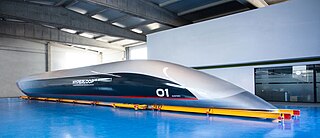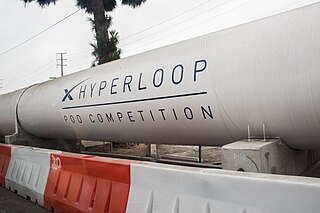
Canada, the world's second-largest country in total area, is dedicated to having an efficient, high-capacity multimodal transportation spanning often vast distances between natural resource extraction sites, agricultural and urban areas. Canada's transportation system includes more than 1,400,000 kilometres (870,000 mi) of roads, 10 major international airports, 300 smaller airports, 72,093 km (44,797 mi) of functioning railway track, and more than 300 commercial ports and harbours that provide access to the Pacific, Atlantic and Arctic oceans as well as the Great Lakes and the St. Lawrence Seaway. In 2005, the transportation sector made up 4.2% of Canada's GDP, compared to 3.7% for Canada's mining and oil and gas extraction industries.

Personal rapid transit (PRT), also referred to as podcars or guided/railed taxis, is a public transport mode featuring small low-capacity automated vehicles operating on a network of specially built guideways. PRT is a type of automated guideway transit (AGT), a class of system which also includes larger vehicles all the way to small subway systems. In terms of routing, it tends towards personal public transport systems.

Light rail transit (LRT) is a form of passenger urban rail transit characterized by a combination of tram and rapid transit features. While its rolling stock is similar to that of a traditional tram, it operates at a higher capacity and speed and often on an exclusive right-of-way. In many cities, light rail transit systems more closely resemble, and are therefore indistinguishable from, traditional underground or at-grade subways and heavy-rail metros.

Wardair Canada was a privately run Canadian airline, founded by Max Ward in 1952 under the name Wardair Ltd, before formally changing its name to "Wardair Canada" in 1976. The airline was acquired by and folded into Canadian Airlines in 1989.

The Siemens–Duewag U2 is a type of light rail vehicle (LRV), built by consortium of Siemens, Duewag and Wegmann & Co built between 1968 and 1990.

Maglev is a system of rail transport whose rolling stock is levitated by electromagnets rather than rolled on wheels, eliminating rolling resistance.
Alberta Provincial Highway No. 2, commonly referred to as Highway 2 or the Queen Elizabeth II Highway, is a major highway in Alberta that stretches from the Canada–United States border through Calgary and Edmonton to Grande Prairie. Running primarily north to south for approximately 1,273 kilometres (791 mi), it is the longest and busiest highway in the province carrying more than 170,000 vehicles per day near Downtown Calgary. The Fort Macleod—Edmonton section forms a portion of the CANAMEX Corridor that links Alaska to Mexico. More than half of Alberta's 4 million residents live in the Calgary–Edmonton Corridor created by Highway 2.
A vactrain is a proposed design for very-high-speed rail transportation. It is a maglev line using partly evacuated tubes or tunnels. Reduced air resistance could permit vactrains to travel at very high (hypersonic) speeds with relatively little power—up to 6,400–8,000 km/h (4,000–5,000 mph). This is 5–6 times the speed of sound in Earth's atmosphere at sea level.

Ultra is a personal rapid transit podcar system developed by the British engineering company Ultra Global PRT.
The city of Calgary, Alberta, has a large transportation network that encompasses a variety of road, rail, air, public transit, and pedestrian infrastructure. Calgary is also a major Canadian transportation centre and a central cargo hub for freight in and out of north-western North America. The city sits at the junction between the "Canamex" highway system and the Trans-Canada Highway.

Light rail is a commonly used mode of public transit in North America. The term light rail was coined in 1972 by the Urban Mass Transportation Administration to describe new streetcar transformations which were taking place in Europe and the United States. The Germans used the term Stadtbahn, which is the predecessor to North American light rail, to describe the concept, and many in UMTA wanted to adopt the direct translation, which is city rail. However, in its reports, UMTA finally adopted the term light rail instead.

Several plans have been proposed for high-speed rail in Canada, the only G7 country that does not have any high-speed rail. In the press and popular discussion, there have been two routes frequently proposed as suitable for a high-speed rail corridor: Edmonton to Calgary via Red Deer and Windsor to Quebec City via London, Kitchener-Waterloo, Toronto, Ottawa and Montreal.

Indian Railways operates India's railway system and comes under the purview of the Ministry of Railways of Government of India. As of 2023, it maintains over 108,706 km (67,547 mi) of tracks and operates over 13,000 trains daily. According to the Ministry of Railways, a route capable of supporting trains operating at more than 160 km/h (99 mph) is considered as a higher speed or semi-high speed rail line.

ET3 Global Alliance is an American open consortium of licensees dedicated to global implementation of Evacuated Tube Transport Technologies (ET3). It was founded by Daryl Oster in 1997 with the goal of establishing a global transportation system utilizing car-sized cargo and passenger capsules traveling in 1.5m diameter tubes via frictionless superconductive maglev.

Hyperloop is a proposed high-speed transportation system for both passengers and freight. The concept was documented by Elon Musk in a 2013 white paper, where the hyperloop was described as a transportation system using capsules supported by an air-bearing surface within a low-pressure tube. Hyperloop systems have three essential elements: tubes, pods, and terminals. The tube is a large, sealed low-pressure system. The pod is a coach at atmospheric pressure that experiences low air resistance or friction inside the tube using magnetic propulsion. The terminal handles pod arrivals and departures. The hyperloop, in the form proposed by Musk, differs from vactrains by relying on residual air pressure inside the tube to provide lift from aerofoils and propulsion by fans; however, many subsequent variants using the name "hyperloop" have been relatively traditional vactrains.

Hyperloop Transportation Technologies, also known as HyperloopTT, is an American research company formed using a crowd collaboration approach to develop around the world commercial transportation systems based on the Hyperloop concept.

Hyperloop One, known as Virgin Hyperloop until November 2022, was an American transportation technology company that worked to commercialize high-speed travel utilizing the Hyperloop concept which was a variant of the vacuum train. The company was established on June 1, 2014, and reorganized and renamed on October 12, 2017.

The Hyperloop Pod Competition was an annual competition sponsored by SpaceX from 2015 to 2019 in which a number of student and non-student teams participated to design—and for some teams, build—a subscale prototype transport vehicle in order to demonstrate technical feasibility of various aspects of the Hyperloop concept. The competitions were open to participants globally, although all competitions and judging occurred in the United States of America.
In gas dynamics, the Kantrowitz limit refers to a theoretical concept describing choked flow at supersonic or near-supersonic velocities. When an initially subsonic fluid flow experiences a reduction in cross-section area, the flow speeds up in order to maintain the same mass-flow rate, per the continuity equation. If a near supersonic flow experiences an area contraction, the velocity of the flow will increase until it reaches the local speed of sound, and the flow will be choked. This is the principle behind the Kantrowitz limit: it is the maximum amount of contraction a flow can experience before the flow chokes, and the flow speed can no longer be increased above this limit, independent of changes in upstream or downstream pressure.
The Chicago Express Loop was a proposed privately funded urban rail transit rapid transit system that will use underground high-speed rail to connect the Chicago Loop to O'Hare International Airport from Block 37. The line was to be constructed by Elon Musk's The Boring Company and use 16-passenger self-driving vehicles built on Tesla chassis. The proposed vehicles would move through tunnels at speeds as high as 150 miles per hour on a concrete track and complete the journey in 12 minutes, which is 3 to 4 times faster than existing alternatives such as the Chicago Transit Authority Blue Line. The proposed vehicles were referred to as skates and are based on the Tesla Model X. The vehicles would cover an 18-mile (29 km) track with eight guiding wheels, including four traditional grounded wheels and four additional side wheels. It was claimed the Boring Company would pay the costs for the construction of the system in exchange for the rights to the future transit fees as well as advertisement, branding and in-vehicle sales revenues. Chicago Express Loop is the official name of the plan. The vehicles will depart as often as every 30 seconds.














